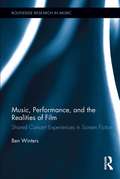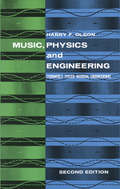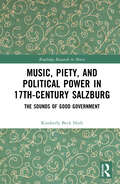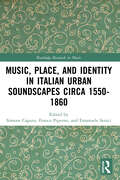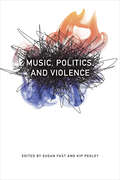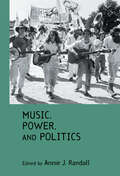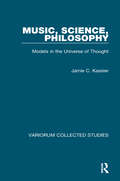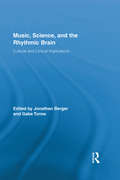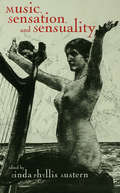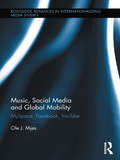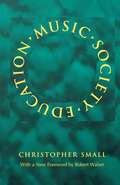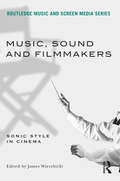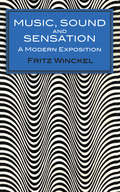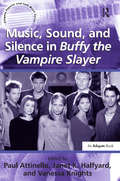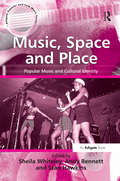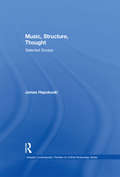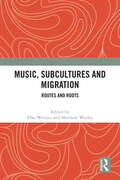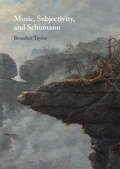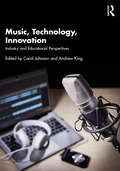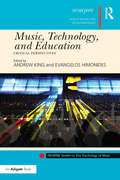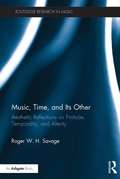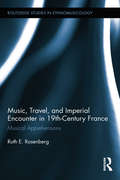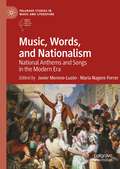- Table View
- List View
Music, Performance, and the Realities of Film: Shared Concert Experiences in Screen Fiction (Routledge Research in Music)
by Ben WintersThis book examines the relationship between narrative film and reality, as seen through the lens of on-screen classical concert performance. By investigating these scenes, wherein the performance of music is foregrounded in the narrative, Winters uncovers how concert performance reflexively articulates music's importance to the ontology of film. The book asserts that narrative film of a variety of aesthetic approaches and traditions is no mere copy of everyday reality, but constitutes its own filmic reality, and that the music heard in a film's underscore plays an important role in distinguishing film reality from the everyday. As a result, concert scenes are examined as sites for provocative interactions between these two realities, in which real-world musicians appear in fictional narratives, and an audience’s suspension of disbelief is problematised. In blurring the musical experiences of onscreen observers and participants, these concert scenes also allegorize music’s role in creating a shared subjectivity between film audience and character, and prompt Winters to propose a radically new vision of music’s role in narrative cinema wherein musical underscore becomes part of a shared audio-visual space that may be just as accessible to the characters as the music they encounter in scenes of concert performance.
Music, Physics and Engineering (Dover Books On Music Ser.)
by Harry F. OlsonNow thoroughly revised and enlarged, this book offers the most comprehensive coverage available of all aspects of the production, reception, and reproduction of sound. Written clearly and concisely, all its chapters can be understood without specialized training in music, physics, engineering, or mathematics.Dr. Olson discusses the nature of sound waves; explains the division of sound into scale patterns and the traditional method of notating them; describes the individual characteristics of all musical instruments currently in use (including the human voice); shows how the ears hear; discusses concert hall and recording studio acoustics, amplification systems, etc; describes the elements of sound reproduction systems from the telephone to the stereo record player; and concludes with a new chapter on the production, development, and potentialities of electronic music.Under these broad headings, readers will find a close analysis of the way in which a violin produces sound; descriptions of carbon, crystal, dynamic, velocity, and unidirectional microphones; a comparison of the relative absorbency of 22 acoustic materials, building materials, and objects; a description of how music can be produced by a digital computer; and much, much more. Conductors will find suggestions on positioning their orchestras; performers will understand the dynamics of their instruments; recording engineers and acousticians will discover a remarkably comprehensive reference work; and music teachers, students, physicists, and enthusiasts in general will find easy access to a vast wealth of information.
Music, Piety, and Political Power in 17th-Century Salzburg: The Sounds of Good Government (Routledge Research in Music)
by Kimberly Beck HiebMusic, Piety, and Political Power in 17th-Century Salzburg traces the role of sacred music in the service of politics at the archbishopric of Salzburg, one of many jurisdictions that made up the Holy Roman Empire in the second half of the 17th century.The author reveals that the use of music to present political, cultural, and religious meanings was not limited to cross-confessional communities, the Imperial capital of Vienna, or other early modern metropolitan centers such as Munich and Paris.Presenting music as a powerful cultural artifact that informs our understanding of the religious and political relationships shaping the history of central Europe, this study expands our understanding of the history of music, absolutism, and Catholicism in the 17th century and will be of interest to scholars working in those areas.
Music, Place, and Identity in Italian Urban Soundscapes circa 1550-1860 (Routledge Research in Music)
by Emanuele Senici Simone Caputo Franco PipernoMusic, Place, and Identity in Italian Urban Soundscapes circa 1550-1860 presents new perspectives on the role music played in the physical, cultural, and civic spaces of Italian cities from the sixteenth to the nineteenth century. Across thirteen chapters, contributors explore the complex connections between sound and space within these urban contexts, demonstrating how music and sound were intimately connected to changing social and political practices. The volume offers a critical redefinition of the core concept of soundscape, considering musical practices through the lenses of territory, space, representation, and identity, in five parts: Soundscape, Phonosphere, and Urban History Urban Soundscapes across Time Urban Soundscapes and Acoustic Communities Urban Soundscapes in Literary Sources Reconstructing Urban Soundscapes in the Digital Era Music, Place, and Identity in Italian Urban Soundscapes circa 1550-1860 reframes our understanding of Italian music history beyond models of patronage, investigating how sounds and musics have contributed to the construction of human identities and communities.
Music, Politics, and Violence (Music Culture)
by Kip Pegley Susan FastMusic and violence have been linked since antiquity in ritual, myth, and art. Considered together they raise fundamental questions about creativity, discourse, and music's role in society. The essays in this collection investigate a wealth of issues surrounding music and violence—issues that cross political boundaries, time periods, and media—and provide cross-cultural case studies of musical practices ranging from large-scale events to regionally specific histories. Following the editors' substantive introduction, which lays the groundwork for conceptualizing new ways of thinking about music as it relates to violence, three broad themes are followed: the first set of essays examines how music participates in both overt and covert forms of violence; the second section explores violence and reconciliation; and the third addresses healing, post-memorials, and memory. Music, Politics, and Violence affords space to look at music as an active agent rather than as a passive art, and to explore how music and violence are closely—and often uncomfortably—entwined.CONTRIBUTORS include Nicholas Attfield, Catherine Baker, Christina Baade, J. Martin Daughtry, James Deaville, David A. McDonald, Kevin C. Miller, Jonathan Ritter, Victor A. Vicente, and Amy Lynn Wlodarski.
Music, Power, and Politics
by Annie J. RandallMusic, Power, and Politics presents sixteen different cultural perspectives on the concept of music as a site of socio-political struggle. Essays by scholars from around the world explore the means by which music's long-acknowledged potential to persuade, seduce, indoctrinate, rouse, incite, or even silence listeners, has been used to advance agendas of power and protest. The essays included examine: music used to convey political ideology in Nazi Germany, apartheid-era South Africa, and modern-day North Korea postcolonial musical efforts to reclaim ethnic heritage in Serbia and the Caribbean music as a means of establishing new cultural identities for recently empowered social groups in the UK and Brazil the subversion of racial stereotypes through popular music in the USA music as a tool of popular resistance to oppressive government policies in modern day Iran and the Bolivian Andes
Music, Science, Philosophy: Models in the Universe of Thought
by Jamie C. KasslerThis book stresses the interrelatedness of knowledge by extricating models that cut across traditional disciplinary boundaries. For example, science can find models from the technology and semantic field of music, music can find its models from the technology and semantic field of science, and each domain may be guided by a philosophical or metaphysical principle - thus, the title of the book. But the book itself is structured as a mirror image of its title. Chapters 1-6 provide instances of the role of music in such domains as epistemology and logic, as well as in the early modern sciences of developmental biology, continuum mechanics, anatomy and physiological psychology, whereas Chapters 7-10 provide instances of what some other domains of knowledge have given back to the philosophy and theory of music.
Music, Science, and the Rhythmic Brain: Cultural and Clinical Implications (Routledge Research in Music)
by Jonathan Berger Gabe TurowThis book studies the effects of repetitive musical rhythm on the brain and nervous system, and in doing so integrates diverse fields including ethnomusicology, psychology, neuroscience, anthropology, religious studies, music therapy, and human health. It presents aspects of musical rhythm and biological rhythms, and in particular rhythmic entrainment, in a way that considers cultural context alongside theoretical research and discussions of potential clinical and therapeutic implications. Considering the effects of drumming and other rhythmic music on mental and bodily functioning, the volume hypothesizes that rhythmic music can have a dramatic impact on mental states, sometimes catalyzing profound changes in arousal, mood, and emotional states via the stimulation of changes in physiological functions like the electrical activity in the brain. The experiments presented here make use of electroencephalography (EEG), galvanic skin response (GSR), and subjective measures to gain insight into how these mental states are evoked, what their relationship is to the music and context of the experience, and demonstrate that they are happening in a consistent and reproducible fashion, suggesting clinical applications. This comprehensive volume will appeal to scholars in cognition, ethnomusicology, and music perception who are interested in the therapeutic potential of music.
Music, Sensation, and Sensuality (Critical and Cultural Musicology)
by Linda Phyllis AusternDivided into three sections, Linda Phyllis Austern collects eighteen, cross-disciplinary essays written by some of the most important names in the field to look at this stimulating topic. The first section focuses on the cultural and scientific ways in which music and the sense of hearing work directly on the mind and body. Part Two investigates how music works on the socially constructed, representational or sexualized body as a means of healing, beautifying and maintaining a balance between the mental and physical. Finally, the book explores the action of music as it is heard and sensed by wider social units, such as the body politic, mass communication, from print to sound recording, and broadcast technologies.
Music, Sexuality and the Enlightenment in Mozart's Figaro, Don Giovanni and Così fan tutte
by Charles FordMusic, Sexuality and the Enlightenment explains how Mozart's music for Le nozze di Figaro, Don Giovanni and Così fan tutte 'sounds' the intentions of Da Ponte's characters and their relationships with one another. Mozart, by way of the infinitely generative and beautiful logic of the sonata principle, did not merely interpret Da Ponte's characterizations but lent them temporal, musical forms. Charles Ford's analytic interpretation of these musical forms concerns processes and structures in detail and at medium- to long-term levels. He addresses the music of a wide range of arias and ensembles, and develops original ways to interpret the two largely overlooked operatic genres of secco recitative and finales. Moreover, Ford presents a new method by which to relate musical details directly to philosophical concepts, and thereby, the music of the operas to the inwardly contradictory thinking of the European Enlightenment. This involves close readings of late eighteenth-century understandings of 'man' and nature, self and other, morality and transgression, and gendered identities and sexuality, with particular reference to contemporary writers, especially Goethe, Kant, Laclos, Rousseau, Sade, Schiller, Sterne and Wollstonecraft. The concluding discussion of the implied futures of the operas argues that their divided sexualities, which are those of the Enlightenment as a whole, have come to form our own unquestioned assumptions about gender differences and sexuality. This, along with the elegant and eloquent precision of Mozart's music, is why Figaro, Giovanni and Così still maintain their vital immediacy for audiences today.
Music, Social Media and Global Mobility: MySpace, Facebook, YouTube (Routledge Advances in Internationalizing Media Studies)
by Ole J. MjosThis book is about the relationship between media, communication and globalization, explored through the unique empirical study of electronic music practitioners’ use of the global social media: MySpace, Facebook, YouTube and Twitter. To understand the significance of the emerging nexus between social media and music in a global context, the book explores various aspects of production, distribution and consumption among electronic music practitioners as they engage with global social media, as well as a historical, political and economic exposition of the rise of this global social media environment. Drawing on interview-based research with electronic music artists, DJs, producers and managers, together with the historical portrayal of the emergence of global social media this pioneering study aims to capture a development taking place in music culture within the wider transformations of the media and communications landscape; from analogue to digital, from national to global, and from a largely passive to more active media use. In doing so, it explores the emergence of a media and communications ecology with increased mobility, velocity and uncertainty. The numerous competing, and rapidly growing and fading social media exemplify the vitality and volatility of the transforming global media, communication and cultural landscape. This study suggests that the music practitioner’s relationship with MySpace, Facebook, YouTube and Twitter and the key characteristics of these global social media, alter aspects of our practical and theoretical understandings of the process of media globalization. The book deploys an interdisciplinary approach to media globalization that takes into account and articulates this relationship, and reflects the enduring power equations and wider continuities and changes within the global media and communications sphere.
Music, Society, Education (Music Culture)
by Christopher Small Robert WalserCited by Soundpost as "remarkable and revolutionary" upon its publication in 1977, Music, Society, Education has become a classic in the study of music as a social force. Christopher Small sets out to examine the social implications of Western classical music, effects that until recently have been largely ignored or dismissed by most musicologists. He strives to view the Western musical tradition "through the mirror of these other musics [Balinese and African] as it were from the outside, and in so doing to learn something of the inner unspoken nature of Western culture as a whole."As series co-editor Robert Walser writes, "By pointing to the complicity of Western culture with Western imperialism, Small challenges us to create a future that is more humane than the past. And by writing a book that enables us to rethink so fundamentally our involvements with music, he teaches us how we might get there."
Music, Sound and Filmmakers: Sonic Style in Cinema
by James WierzbickiMusic, Sound and Filmmakers: Sonic Style in Cinema is a collection of essays that examine the work of filmmakers whose concern is not just for the eye, but also for the ear. The bulk of the text focuses on the work of directors Wes Anderson, Ingmar Bergman, the Coen brothers, Peter Greenaway, Krzysztof Kieślowski, Stanley Kubrick, David Lynch, Quentin Tarantino, Andrey Tarkovsky and Gus Van Sant. Significantly, the anthology includes a discussion of films administratively controlled by such famously sound-conscious producers as David O. Selznick and Val Lewton. Written by the leading film music scholars from Europe, North America, and Australia, Music, Sound and Filmmakers: Sonic Style in Cinema will complement other volumes in Film Music coursework, or stand on its own among a body of research.
Music, Sound and Sensation: A Modern Exposition
by Fritz WinckelRelated closely to the field of physical acoustics is that of psychoacoustics, which deals with the phenomena of musical hearing from a psychological and aesthetic point of view. One of the major contributors to our understanding of the subject is Fritz Winckel. When this book first appeared in German in 1960, reviewers pressed for an English translation. This Dover volume is an answer to that demand: it makes Professor "Winckel's important study generally available to English-language readers for the very first time." It has been extensively revised and updated by the author.In his thought-provoking study, Professor Winckel applies the findings of technical researches in acoustics to the practice of music, covering many different aspects of recent psychoacoustical researches: the evaluation of loudness and the dissolution power of the car; the influence of the acoustical properties of the concert hall on the hearing process; the function of time variation and rhythm in musical perception; the evaluation of the sound spectrum including the unharmonic components. He surveys extensively the German and English literature in the field, organizing his information into chapters on stationary sound, the onset behavior of sound, the concept of space, the concept of time, the evaluation of sound through the hearing mechanism, unclarity in musical structures, simultaneously sounding tones, electroacoustic sound structure, and the effect of music on the listener.This book should prove equally useful to acousticians, sound engineers, and others working in this area of applied physics and to composers, performers, and musicologists concerned with the technical aspects of music. Psychologists working in the field of sense perception will also find much of value here.New translation by Thomas Binkley of the 1960 German edition of Phänomene des musikalischen Hörens, with revisions and corrections by the author.
Music, Sound and Space
by Georgina BornMusic, Sound and Space is the first collection to integrate research from musicology and sound studies on music and sound as they mediate everyday life. Music and sound exert an inescapable influence on the contemporary world, from the ubiquity of MP3 players to the controversial use of sound as an instrument of torture. In this book, leading scholars explore the spatialisation of music and sound, their capacity to engender modes of publicness and privacy, their constitution of subjectivity, and the politics of sound and space. Chapters discuss music and sound in relation to distinctive genres, technologies and settings, including sound installation art, popular music recordings, offices and hospitals, and music therapy. With international examples, from the Islamic soundscape of the Kenyan coast, to religious music in Europe, to First Nation musical sociability in Canada, this book offers a new global perspective on how music and sound and their spatialising capacities transform the nature of public and private experience.
Music, Sound, and Silence in Buffy the Vampire Slayer (Ashgate Popular And Folk Music Ser.)
by JanetK. HalfyardThe intense and continuing popularity of the long-running television show Buffy the Vampire Slayer (1997-2003) has long been matched by the range and depth of the academic critical response. This volume, the first devoted to the show's imaginative and widely varied use of music, sound, and silence, helps to develop an increasingly important and inadequately covered area of research - the many roles of music in contemporary television. In addressing this significant gap, this book provides an exemplary overview of the functions of music and sound in the interpretation of a television show. This is done through analyses that focus on scoring and source music, the title theme, the music production process, the critically acclaimed musical episode (voted number 13 in Channel Four's One Hundred Greatest Musicals), the symbolic and dramatic use of silence, and the popular reception of the show by its international fan base. In keeping with contemporary trends in the study of popular musics, a variety of critical approaches are taken from musicology, cultural studies, and media and communication studies, specifically employing critique, musical analysis, industry studies, and hermeneutics.
Music, Space and Place: Popular Music and Cultural Identity (Ashgate Popular And Folk Music Ser.)
by Andy BennettMusic, Space and Place examines the urban and rural spaces in which music is experienced, produced and consumed. The editors of this collection have brought together new and exciting perspectives by international researchers and scholars working in the field of popular music studies. Underpinning all of the contributions is the recognition that musical processes take place within a particular space and place, where these processes are shaped both by specific musical practices and by the pressures and dynamics of political and economic circumstances. Important discourses are explored concerning national culture and identity, as well as how identity is constructed through the exchanges that occur between displaced peoples of the world's many diasporas. Music helps to articulate a shared sense of community among these dispersed people, carving out spaces of freedom which are integral to personal and group consciousness. A specific focal point is the rap and hip hop music that has contributed towards a particular sense of identity as indigenous resistance vernaculars for otherwise socially marginalized minorities in Cuba, France, Italy, New Zealand and South Africa. New research is also presented on the authorial presence in production within the domain of the commercially driven Anglo-American music industry. The issue of authorship and creativity is tackled alongside matters relating to the production of musical texts themselves, and demonstrates the gender politics in pop. Underlying Music, Space and Place, is the question of how the disciplines informing popular music studies - sociology, musicology, cultural studies, media studies and feminism - have developed within a changing intellectual climate. The book therefore covers a wide range of subject matter in relation to space and place, including community and identity, gender, race, 'vernaculars', power, performance and production.
Music, Structure, Thought: Selected Essays (Ashgate Contemporary Thinkers On Critical Musicology Ser.)
by James HepokoskiAmong the most original and provocative musicological writers of his generation, James Hepokoski has elaborated new paradigms of inquiry for both music history and music theory. Advocating fundamental shifts of methodological reorientation within the quest for potential musical meanings, his work spans both disciplines and offers substantial challenges for each. At its core is the conviction that a close study of musical genres, procedures, and structures those qualities of a composition that are specifically musical is essential to any responsible hermeneutic enterprise. Selected from writings from 1984 to 2008, this collection of essays provides a generous introduction to the author‘s most innovative and influential work on a wide variety of topics: musicological methodology, issues of staging and performance, Italian opera, program music, and exemplary studies of individual pieces.
Music, Subcultures and Migration: Routes and Roots
by Matthew Worley Elke WeesjesThis edited volume concentrates on the period from the 1940s to the present, exploring how popular music forms such as blues, disco, reggae, hip hop, grime, metal and punk evolved and transformed as they traversed time and space. Within this framework, the collection traces how music and subcultures travel through, to and from democracies, autocracies and anocracies.The chosen approach is multidisciplinary and deliberately diverse. Using both archival sources and oral testimony from a wide variety of musicians, promoters, critics and members of the audience, contributors from a range of academic disciplines explore music and subcultural forms in countries across Asia, Europe, Oceania, North America and Africa. They investigate how far the meaning of music and associated subcultures change as they move from one context to another and consider whether they transcend or blur parameters of class, race, gender and sexuality.
Music, Subjectivity, and Schumann Music, Subjectivity, and Schumann
by Benedict TaylorThe concept of subjectivity is one of the most popular in recent scholarly accounts of music; it is also one of the obscurest and most ill-defined. Multifaceted and hard to pin down, subjectivity nevertheless serves an important, if not indispensable purpose, underpinning various assertions made about music and its effect on us. We may not be exactly sure what subjectivity is, but much of the reception of Western music over the last two centuries is premised upon it. Music, Subjectivity, and Schumann offers a critical examination of the notion of musical subjectivity and the first extended account of its applicability to one of the composers with whom it is most closely associated. Adopting a fluid and multivalent approach to a topic situated at the intersection of musicology, philosophy, literature, and cultural history, it seeks to provide a critical refinement of this idea and to elucidate both its importance and limits.
Music, Technology, Innovation: Industry and Educational Perspectives
by Andrew King Carol JohnsonMusic, Technology, Innovation: Industry and Educational Perspectives draws upon cutting-edge practice in the use of technology from both a pedagogical and industry perspective. Situated within the latest research, this edited volume explores technological innovation from a musical perspective, examines current trends within the industry, and carefully considers them from an educational perspective.Noted throughout history, music education is responsive to industry innovations. However, emerging technologies often begin with over-hyped promises before they move through various phases of development and are then repurposed for learning and teaching. Educators can adopt an innovation and develop a framework that is pedagogically sound and learner-centred. Based on these ideas, the authors together highlight industry innovations that have potential outcomes for engaging students in music learning within research-informed practices, build upon these ideas and identify proactive mechanisms for teaching music education, and work towards developing a framework for understanding these phenomena. The chapters address key topics including the ethics of technology, AI and music, online performance and teaching, gamification, big data, teaching audio production, acoustic ecology, and more. The examination of areas in contemporary innovation can further support the potential to empower teachers and students to understand the opportunities for teaching, sustainability, and growth in music education.
Music, Technology, and Education: Critical Perspectives (SEMPRE Studies in The Psychology of Music)
by Andrew King Evangelos HimonidesThe use of technology in music and education can no longer be described as a recent development. Music learners actively engage with technology in their music making, regardless of the opportunities afforded to them in formal settings. This volume draws together critical perspectives in three overarching areas in which technology is used to support music education: music production; game technology; musical creation, experience and understanding. The fourteen chapters reflect the emerging field of the study of technology in music from a pedagogical perspective. Contributions come not only from music pedagogues but also from musicologists, composers and performers working at the forefront of the domain. The authors examine pedagogical practice in the recording studio, how game technology relates to musical creation and expression, the use of technology to create and assess musical compositions, and how technology can foster learning within the field of Special Educational Needs (SEN). In addition, the use of technology in musical performance is examined, with a particular focus on the current trends and the ways it might be reshaped for use within performance practice. This book will be of value to educators, practitioners, musicologists, composers and performers, as well as to scholars with an interest in the critical study of how technology is used effectively in music and music education.
Music, Time, and Its Other: Aesthetic Reflections on Finitude, Temporality, and Alterity (Routledge Research in Music)
by Roger W. SavageMusic, Time, and Its Other explores the relation between the enigmatic character of our temporal experiences and music’s affective power. By taking account of competing concepts of time, Savage explains how music refigures dimensions of our experiences through staking out the borderlines between time and eternity. He examines a range of musical expressions that reply to the deficiency born from the difference between time and an order that exceeds or surpasses it and reveals how affective tonalities of works by Bach, Carolan, Debussy, Schoenberg, Messiaen, and Glass augment our understanding of our temporal condition. Reflections on the moods and feelings to which music gives voice counterpoint philosophical investigations into the relation between music’s power to affect us and the force that the present has with respect to the initiatives we take. Music, Time, and Its Other thus sets out a new approach to music, aesthetics, politics, and the critical roles of judgment and imagination.
Music, Travel, and Imperial Encounter in 19th-Century France: Musical Apprehensions (Routledge Studies in Ethnomusicology)
by Ruth RosenbergThis book considers the activities and writings of early song collectors and proto-ethnomusicologists, memoirists, and other "musical travelers" in 19th-century France. Each of the book’s discrete but interrelated chapters is devoted to a different geographic and discursive site of empire, examining French representations of musical encounters in North America, the Middle East, as well as in contested areas within the borders of metropolitan France. Rosenberg highlights intersections between an emergent ethnographie musicale in France and narratives of musical encounter found in French travel literature, connecting both phenomena to France’s imperial aspirations and nationalist anxieties in the period from the Revolution to the late-nineteenth century. It is therefore an excellent research tool for scholars in the fields of ethnomusicology, musicology, cultural studies, literary history, and postcolonial studies.
Music, Words, and Nationalism: National Anthems and Songs in the Modern Era (Palgrave Studies in Music and Literature)
by Javier Moreno-Luzón María Nagore-FerrerMusic, Words and Nationalism: National Anthems and Songs in the Modern Era considers the concept of nationalism from 1780 to 2020 through anthems and national songs as symbolic and representative elements of the national identity of individuals, peoples, or collectivities. The volume shows that both the words and music of these works reveal a great deal about the defining features of a nation, its political and cultural history, and its self-perception. The book takes an interdisciplinary approach that provides a better understanding of the role of national anthems and songs in the expression of national identities and nationalistic goals. From this perspective, the relationship between hymns and political contexts, their own symbolic content (both literary and musical) and the role of specific hymns in the construction of national sentiments are surveyed.
